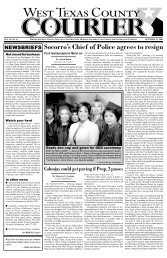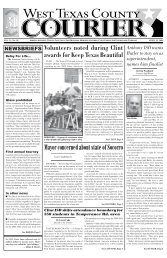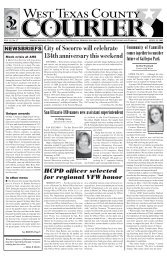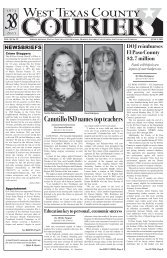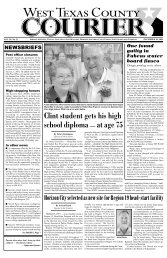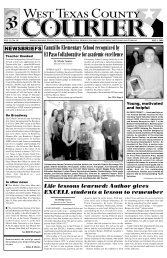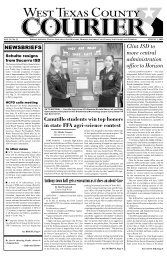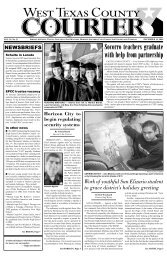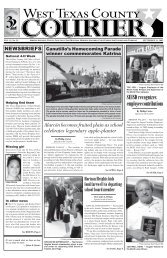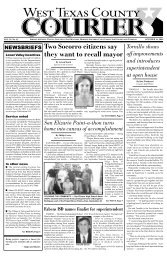You also want an ePaper? Increase the reach of your titles
YUMPU automatically turns print PDFs into web optimized ePapers that Google loves.
Page 2 WEST TEXAS COUNTY COURIER<br />
March 30, 2006<br />
So I<br />
honked.<br />
Good and<br />
loud and<br />
long.<br />
And why not It just makes me<br />
crazy, the driving mentality of people<br />
who will pull into the intersection<br />
knowing full well that the green light<br />
isn’t going to last long enough for the<br />
backed up traffic ahead to clear.<br />
So they just sit there, blocking the<br />
intersection, blatantly breaking the<br />
law, effectively ruining other drivers’<br />
opportunity to move ahead when the<br />
light changes. They aren’t helping<br />
matters any. They are just clogging<br />
up the entire process so that it will<br />
be even slower and more frustrating<br />
than ever.<br />
The same thing occurs at the on<br />
ramps to the freeway. If people would<br />
just keep an eye on other cars and<br />
slow down or speed up accordingly,<br />
cars could enter the flow of traffic<br />
with relatively little disruption. Do<br />
you think this happens<br />
You bet your sweet life it doesn’t.<br />
The folks on the freeway feel like<br />
they own the road. Unfortunately, so<br />
do those coming on. So, instead of<br />
melding in a cooperative flow, we<br />
attempt to muscle our way on or force<br />
the oncoming car into the emergency<br />
lane, which effectively slows everything<br />
down.<br />
We used to call this process biting<br />
off your nose to spite your face.<br />
Okay, so why the tirade Well, I’ve<br />
been thinking that since Americans<br />
practically live in our cars we have<br />
to establish working relationships<br />
with hundreds, even thousands of<br />
other drivers, most of them perfect<br />
strangers. The problem is that we<br />
don’t have any truly effective way to<br />
address the folks in the other car.<br />
Brake lights and turn signals were<br />
originally designed to meet this need<br />
nineteenseventythree<br />
33YEARS<br />
t w o t h o u<br />
s a n d six<br />
One perspective<br />
By Francis Shrum<br />
Car talk<br />
but they have become increasingly<br />
ineffective. These rudimentary signals<br />
are so basic that today’s “advanced”<br />
driver generally chooses to<br />
ignore them, considers them a sign<br />
of weakness or, if noticed, considers<br />
them a warning that it is time to speed<br />
up so that whatever maneuver this<br />
other driver wants to make doesn’t<br />
impede our progress. Sort of like a<br />
yellow at the stop light.<br />
Honking is the vehicular equivalent<br />
of shouting. It wasn’t intended<br />
that way in the beginning but because<br />
we are such a prideful and defensive<br />
society, that’s the way we interpret it<br />
when someone honks at us.<br />
Because the horn on a car usually<br />
has only one monotonous sound it is<br />
impossible to use different phrases,<br />
tones or expressions to soften our<br />
communication as we can do when<br />
speaking. We can’t say please, excuse<br />
me, or thank you. All we can do is<br />
shout.<br />
This has had some dire results. Not<br />
long ago I saw a piece on the news<br />
where this man was driving through<br />
an unfamiliar city neighborhood<br />
when his path was blocked by a<br />
group of youths in the street. So he<br />
tooted his horn. They promptly<br />
dragged him out of the car and beat<br />
him insensible. He didn’t die but he’ll<br />
never be the same.<br />
Not every honk evokes this response,<br />
obviously, but it does illustrate<br />
the need for improved driver<br />
communication, since most of us are<br />
oblivious to the needs of others unless<br />
they are pointed out to us. This<br />
is usually because we are involved<br />
in other activities while driving, like<br />
talking on the cell phone, smoking,<br />
eating, watching a video or putting<br />
on makeup.<br />
One solution might be that, since<br />
we all love to use our cell phones<br />
while driving, we should post our cell<br />
phone numbers in a prominent place<br />
on our automobiles so that other<br />
motorists can call us to negotiate exactly<br />
what it will take for us to allow<br />
them to enter or exit the freeway efficiently.<br />
Another inventive method is to<br />
carry a marker and writing pad in<br />
your car. Then you can write your<br />
requests or comments in large print<br />
and hold it up to the window for the<br />
other motorist to read — if you can<br />
get his attention, which may require,<br />
well… honking. At least this will give<br />
you a way to explain why you were<br />
so rude as to shout at him.<br />
This method, however, may be ineffective<br />
for two-way communication<br />
unless the other guy is equally<br />
equipped with marker and pad, which<br />
is unlikely. But if he’s the kind of guy<br />
who carries markers and writing<br />
pads, he’s probably already driving<br />
in a fairly courteous manner, so you<br />
have nothing you need to discuss.<br />
I’ve heard of other more direct but<br />
less civilized methods of communicating<br />
with other drivers which involve<br />
things like paint balls, stupid<br />
stickers and guns. I don’t recommend<br />
these. We even watched, aghast, as a<br />
young man leaned out the window<br />
of a car on the freeway to pass a note<br />
to another car.<br />
That could have been a real conversation<br />
stopper.<br />
Retired policeman to run for Socorro Council<br />
SOCORRO — A long time<br />
Socorro resident and retired City of<br />
El Paso police officer has announced<br />
his candidacy for an atlarge<br />
Socorro City Council seat.<br />
Sergio Cox, a resident of Socorro<br />
since 1967 and a graduate of<br />
Socorro High School’s fifth graduating<br />
class in 1972, will make his<br />
first foray into the political arena<br />
with his bid for the council. Cox<br />
retired from the El Paso Police<br />
Department in 2001 at the rank of<br />
sergeant.<br />
Among his accomplishments,<br />
Cox cites his successful role in raising<br />
not one, but two families. After<br />
his father passed away in 1975, Cox<br />
helped his mother Alicia raise his<br />
four younger siblings. At the same<br />
time, he was busy raising his own<br />
young family with his wife Marie<br />
Elmore Cox, currently in her 18th<br />
year teaching at Socorro High. They<br />
raised three children, all of whom<br />
are Socorro High and UTEP graduates.<br />
Cox also now has eight grandchildren<br />
ranging in age from 2 to 9.<br />
Prior to his retirement, Cox spent<br />
26 years as a police officer with<br />
tenures as a patrolman, a detective<br />
and lastly as a sergeant. During that<br />
time he also worked as an elected<br />
Director on the Board of the El<br />
Paso Municipal Police Officer’s<br />
Association, and was involved in<br />
contract and labor issues for El<br />
Paso police officers.<br />
Cox readily admits that he is a political<br />
newcomer but is quick to<br />
point out that for this reason he has<br />
no political ties or relationships<br />
with special interest groups. “I will<br />
finance my own campaign and I<br />
will not accept contributions from<br />
any business that might seek to gain<br />
influence with the council.”<br />
“My sole interest lies in the betterment<br />
of the City of Socorro and<br />
its people,” Cox said. He added, “If<br />
elected, I will sit on council with<br />
only the best interests of the community<br />
at heart.” He also promises<br />
to be a diligent and hard worker as<br />
a council member.<br />
Cox also added that he has no further<br />
political aspirations and states<br />
that this bid for office is not designed<br />
to further a political career.<br />
Cox points toward recent events<br />
and issues surrounding the current<br />
administration which he says have<br />
cast a negative light on the Socorro<br />
city government. “I want to bring<br />
honesty and integrity back to the<br />
forefront,” he said.<br />
SERVING ANTHONY, VINTON, CANUTILLO, EAST MONTANA, HORIZON, SOCORRO, CLINT, FABENS, SAN ELIZARIO AND TORNILLO<br />
PUBLISHED:<br />
Published each Thursday by<br />
Homesteader News, Inc. Appreciation<br />
to our many contributors. Office open<br />
Monday through Thursday.<br />
COPYRIGHT:<br />
Entire contents © 2006 Homesteader<br />
News, Inc. Individual authors retain all<br />
rights. Pictures, drawings and written<br />
material appearing in the <strong>West</strong> <strong>Texas</strong><br />
<strong>County</strong> <strong>Courier</strong> may not be used or<br />
reproduced without written permission<br />
of Homesteader News, Inc.<br />
LETTERS TO THE EDITOR:<br />
Letter must not be more than 250<br />
words in length. They should be<br />
dated, must be signed and have an<br />
address and daytime phone number.<br />
Only the name and city will be printed<br />
with the letter. The <strong>Courier</strong> reserves<br />
the right not to print letters to the<br />
editor or other submitted materials it<br />
considers inappropriate.<br />
★<br />
Member <strong>Texas</strong> Community<br />
Newspaper Association<br />
AD DEADLINE:<br />
Monday 4 p.m. for Thursday<br />
publication.<br />
CLASSIFIED RATES<br />
$5 for 15 words, $10 for 35 words. Ad<br />
must be in writing and pre-paid. The<br />
<strong>Courier</strong> reserves the right not to print<br />
classified advertising it considers<br />
inappropriate.<br />
DISPLAY RATES:<br />
Open rate — $20 per column inch.<br />
Call for more information or to set an<br />
appointment. The <strong>Courier</strong> reserves<br />
the right not to print advertising it<br />
considers inappropriate.<br />
MAIL SUBSCRIPTIONS:<br />
52 issues for $35.<br />
Delivery via 1st class mail.<br />
ADDRESS:<br />
14200 Ashford<br />
Horizon City, TX 79928<br />
Phone: 852-3235<br />
Fax: 852-0123<br />
E-mail: wtxcc@wtccourier.com<br />
Website: wtccourier.com<br />
Publisher<br />
Rick Shrum<br />
Business Manager<br />
Francis D. Shrum<br />
Contributors<br />
Don Woodyard<br />
Steve Escajeda<br />
Arleen Beard • Jan Engels<br />
Homesteader<br />
Est. 1973<br />
News, Inc.<br />
Over the<br />
next few<br />
months, the<br />
El Paso community<br />
will<br />
have the opportunity to experience a<br />
prominent exhibit by the<br />
Smithsonian Institution right here in<br />
the border region. Known as Our<br />
Journeys/Our Stories: Portraits of<br />
Latino Achievement, this photographic<br />
exhibit opened at the<br />
Chamizal National Memorial this<br />
past Friday and runs through June.<br />
The Smithsonian Center for Latino<br />
Initiatives this exhibit, which provides<br />
an overview of Latino achievement<br />
and influence in the U.S. It features<br />
25 photographic portraits of<br />
U.S. Latinos from all walks of life,<br />
including Nobel laureates, journalists,<br />
artists, athletes, entrepreneurs,<br />
politicians, and community activists.<br />
Reyes Reports By U.S. Rep. Silvestre Reyes<br />
Smithsonian at Chamizal<br />
New Mexico Gov. Bill<br />
Richardson, athlete Rebecca Lobo,<br />
author Sandra Cisneros, and Medal<br />
of Honor recipient Alfred Rascon are<br />
among those featured in the exhibit,<br />
and each photo is accompanied by<br />
bilingual biographical highlights and<br />
excerpts from oral history interviews.<br />
It has been a multi-year process to<br />
bring Our Journeys to El Paso, which<br />
I toured when it was on display at<br />
the National Museum of American<br />
History in Washington, DC in 2004.<br />
I found the exhibit inspiring. I<br />
thought many in El Paso would have<br />
the same reaction, and quickly hosted<br />
Project Director Evelyn Figueroa of<br />
the Smithsonian Institution on my<br />
weekly television show, Congress on<br />
the Border, where I emphasized that<br />
El Paso would be a perfect host city<br />
for the traveling exhibit.<br />
Since then, I have been working<br />
with the Smithsonian Institution, the<br />
Chamizal National Memorial, and<br />
the Ford Motor Company Fund,<br />
which is funding the traveling exhibit.<br />
The Ford Motor Company<br />
Fund is also providing a $60,000 education/outreach<br />
grant to the Chamizal<br />
to develop education programs for<br />
the El Paso community, as well as<br />
funding to establish a local Committee<br />
of Honor, which has brought together<br />
a broad cross-section of local<br />
leaders to increase outreach and<br />
awareness of the Chamizal and the<br />
exhibit.<br />
The Chamizal furthers education<br />
and understanding about the cooperation<br />
between and cultural values of<br />
the United States and Mexico, and is<br />
a fitting backdrop for an exhibit featuring<br />
Latinos contributions to the<br />
United States. The exhibit will run<br />
from March 24 to June 11.



